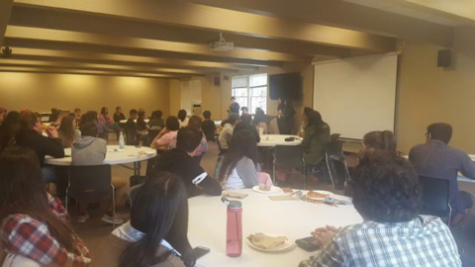Immigration: more than crossing the border
April 5, 2017

Immigration to the U.S. is complex and should not be viewed as an issue exclusive to Mexicans, said a panel of Linfield professors Monday night in Riley Hall.
Linfield’s political science department partnered with Voto Latino for Monday’s Pizza and Politics panel discussion on immigration facts and myths. The panel included Assistant Dean Gerardo Ochoa, history professor Bailey Glasco and German professor Emina Musanovic. A few dozen students attended the event, filling almost every seat at the seven circular tables.
Senior Sara Gomez and junior April Alvarez asked the panel and students questions about immigration policy and sanctuary cities, encouraging all who attended to vocalize their concerns and inform themselves.
Gomez and Alvarez represented Voto Latino, a young club with connections to the Washington DC-based Voto Latino, a nonprofit organization created to advocate for Latinos. The club is open to all students.
The panel discussion began when Alvarez asked the students, who were divided into groups, what they knew about immigration. Some students like junior Kenna Whatley came to the discussion wanting to learn more than what was covered during the election. Others, like junior Mike Sheldon, came knowing how complicated the issue is and wanting to dispel stereotypes.
Panel members Ochoa, Glasco and Musanovic answered the terminology questions asked by Gomez, Alvarez and other students. They explained the distinction between refugees and migrants, sanctuary cities, DACA and the citizenship application process, confirming Sheldon’s statement that immigration is “not just Mexicans walking across the border.”
There are about 400,000 undocumented immigrants in Oregon, Ochoa said, and the number one country they are coming from is not Mexico. In fact, most of the immigrants in the country are here illegally because their visas expired, Glasco said. The term “immigration crisis” is also inaccurate, she said. Immigration data has been stable since 2008 and immigration law has not changed since 1986.
One student asked if immigrants were really “stealing our jobs,” a concept also commonly associated with Mexican immigrants. In reality, Mexican immigrants take jobs in unskilled labor markets like domestic, restaurant and farm work, Glasco and Ochoa said.
Alvarez asked why some colleges are being declared “sanctuary campuses” while Linfield is not. After much deliberation, Linfield officials decided not to call the college a sanctuary for fear of exposing undocumented students, Ochoa said.
The term “sanctuary city” itself lacks a legal definition, Musanovic and Ochoa said. It is meaningful in its symbolism for people but its lack of legal protection does not make it a solution for ICE raids and deportation increases.
Ochoa referenced some instances involving police officers in Portland, saying that although the police departments of sanctuary cities in general will not cooperate with ICE, that does not mean individuals like sheriffs and police officers are held to the same standard.
“Local law enforcement…is about trust,” Glasco said, and arguments are circulating that getting ICE involved in local law enforcement proceedings makes communities less safe. She said the term “sanctuary” gives people a false sense of security and that students should educate themselves on immigration laws.
The complexity of the issue and the system became more apparent when Musanovic discussed her experience as a Bosnian refugee.
She explained the difference between being classified as a refugee versus an economic migrant. Refugees need to prove they are fleeing state-sanctioned violence to gain the classification and apply for asylum. In Europe, there are a list of “safe” countries refugees can settle in and those hoping to apply for asylum have to do so in the first safe country they reach.
A lot of people cross the United States’ borders and do not fit the refugee category, Ochoa said.
